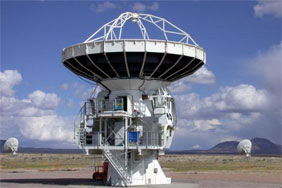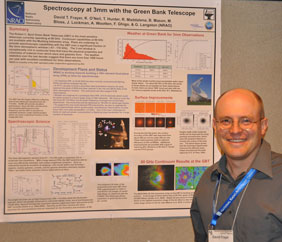NRAO eNews
Volume 3, Issue 6 • June 16, 2010
Upcoming Events
 Call for Expression of Interest in the Scientific Use of the ALMA Vertex Prototype Antenna Deadline
Call for Expression of Interest in the Scientific Use of the ALMA Vertex Prototype Antenna Deadline
July 1, 2010 5:00 PM EDT
 NRAO Proposal Deadline
NRAO Proposal Deadline
October 1, 2010 5:00 PM EDT
 SC10: The Future of Discovery
SC10: The Future of Discovery
November 13–19, 2010 | New Orleans, LA
 217th American Astronomical Society Meeting
217th American Astronomical Society Meeting
January 9–13, 2011 | Seattle, WA
 ALMA: Extending the Limits of Astrophysical Spectroscopy
ALMA: Extending the Limits of Astrophysical Spectroscopy
January 15–17, 2011 | Victoria, British Columbia
Prof. Reinhard Genzel Awarded the 2010 Jansky Lectureship
Fred K.Y. Lo

The National Radio Astronomy Observatory is pleased to announce that the 2010 Karl G. Jansky Lectureship has been awarded to Prof. Reinhard Genzel, Director of the Max Plank Institute for Extraterrestrial Physics and Professor at the University of California, Berkeley. The Jansky Lectureship is an honor established by the Trustees of Associated Universities, Inc., to recognize outstanding contributions to the advancement of radio astronomy. Each award recipient presents a scientific lecture at the NRAO facilities. The title, abstract, and schedule for Prof. Reinhard's Jansky Lectures will be announced later this summer.
Prof. Genzel received his Ph.D. from the University of Bonn in 1978, where he wrote his thesis on water masers in star-forming regions, and then went to the Harvard-Smithsonian Center for Astrophysics where he developed statistical parallax methods to determine the distance to water maser sources. In 1980, he moved to the University of California - Berkeley as a Miller Fellow and in 1981 joined the Physics Department faculty. Prof. Genzel left Berkeley in 1986 to become Director at the Max-Plank Institute for Extraterrestrial Physics, although in 1999 he returned to Berkeley as a Professor on a part-time basis.
Prof. Genzel's work has been recognized with many honors and awards, including the Newton Lacy Pierce Prize (1986), the Gottfried Wilhelm Leibniz Prize (1990), the De Vaucouleurs Medal (2000), the Janssen Prize (2000), the Stern Gerlach Medal for experimental physics (2003), the Balzan Prize for infrared astronomy (2007), the Shaw Prize (2008), and the "Galileo 2000" Prize (2009). He became a foreign member of the United States National Academy of Sciences in 2000.
Prof. Genzel's professional interests lie in experimental astrophysics. He and his collaborators have developed instrumentation at sub-millimeter and infrared wavelengths to probe the central regions of galaxies, including the Milky Way, in order to test the paradigm that active galactic nuclei contain massive black holes. Prof. Genzel and collaborators were able to show from near-infrared imaging observations of the motions of stars within the central few light-days of the Milky Way that there must be a central black hole containing ~106 solar masses. More generally, Prof. Genzel is interested in understanding whether accretion onto massive black holes or star formation powers active galaxies.
Prof. Genzel continues to develop instrumentation and techniques in adaptive optics and interferometry to push the frontiers of high-resolution imaging and spectroscopic observations of galaxies using such diverse facilities as SOFIA, Herschel, the VLT, and the Keck telescopes.
We are pleased to have a scientist of Prof. Genzel's stature for the 2010 Jansky Lectureship, and we look forward to his visit and presentation this fall.
Cometary Workshop in Green Bank
Felix J. Lockman (NRAO), Amy J. Lovell (Agnes Scott College), Anthony J. Remijan (NRAO)
A Workshop on Cometary Radio Astronomy was held 17-19 May 2010 at the NRAO Green Bank Observatory, bringing together 40 scientists from Europe, Asia, and North America. The meeting was motivated by the profound leap in instrumental capabilities that will occur in the next few years with the advent of ALMA, the EVLA, and the availability of wide-field focal plane cameras on the GBT and the Large Millimeter Telescope.
The Workshop lasted two and one half days and contained a mix of research talks, panel discussions, and presentations on new radio instrumentation. The weather cleared just long enough for a tour to the top of the GBT. Many attendees were new to radio astronomy and saw for the first time the potential of radio observations for the advance of their field.
The workshop website contains the agenda and list of participants, and will host copies of the
presentations as we receive them.
We thank the Green Bank staff for making the Workshop a success. Financial support was received from Green Bank Operations, the NRAO Office of Science and Academic Affairs, the University of Virginia Center for Chemistry in the Universe, and Associated Universities, Inc.
Call for Expression of Interest in the Scientific Use of the ALMA Vertex Prototype Antenna
On behalf of the National Science Foundation (NSF,) the NRAO issues this Call for Expression of Interest for the scientific use of the ALMA Vertex Prototype Antenna from the US scientific community and from the communities that form the North American ALMA region (i.e. Canada and Taiwan.). Therefore, it is expected that all Expressions of Interest will involve US institutions or institutions in collaboration with US institutions.
The ALMA Vertex Prototype Antenna, a property of the NSF, is a high precision 12-m diameter mm/submm antenna, currently located at the site of the Very Large Array on the Plains of San Agustin in New Mexico. Further information on the prototype antenna may be obtained from the article by Mangum et al (Publications of the Astronomical Society of the Pacific, 118: 1257–1301, 2006 September.)
Expressions of Interest should provide a description of the proposed science use of the prototype Vertex ALMA antenna and a statement of where the antenna will be sited. The NSF will not, nor will NRAO, provide any funding for the removal, transportation, refurbishment, re-assembly, commissioning and operation of the prototype ALMA antenna. Thus, the Expression of Interest must also include a statement on the source of funding involved.
The prototype ALMA antenna is offered “as is” along with the title of ownership, and neither NSF or NRAO will assume responsibility for its condition or performance. It was last operated as part of the ALMA Test Facility in December 2008.
The Expression of Interest should be submitted to the NRAO Director at 520 Edgemont Road, Charlottesville, VA 22903, USA by 1 July 2010. The final decision on the disposition of the prototype Vertex Prototype Antenna will be made and announced by the NSF.
Should you have any questions, please contact Patrick Donahue (Manager, Contracts and Procurement) on +1.434.296.0264 or pdonahue@nrao.edu.
ALMA Array Now a Handful
Al Wootten

Figure 1: Five ALMA antennas explore the southern sky from the Chajnantor plain at over 5000m elevation. Credit: Norikazu Mizuno (ALMA/ESO/NAOJ/NRAO).
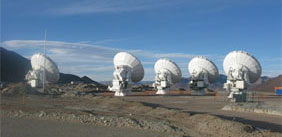
Figure 2: Can you see what they see? Five antennas move in synchrony as they undergo commissioning. Credit: Nick Whyborn (ALMA/ESO/NAOJ/NRAO).

Figure 3: The fifth antenna is delivered to the AOS by the ALMA transporter on 31 May 2010. Credit: DTS (ALMA/ESO/NAOJ/NRAO).
On 31 May, ALMA antenna DV05 arrived on pad T701, a location eventually slated to support one of the Atacama Compact Array (ACA) 12m antennas. This new arrival joined four other antennas, including DV03 that had been moved to nearby pad N605 a scant two weeks before.
The achievement of closure amplitude with the four-antenna array had been announced at the “Preparing for ALMA” Special session held at the May 2010 Miami meeting of the American Astronomical Society. Astronomers and engineers have now succeeded in linking all five antennas for commissioning activities. The ten baselines available between these antennas offer a marked improvement in ALMA imaging ability. By Early Science, about a year from now, sixteen antennas will provide 120 baselines and enable scientists to explore the southern sky with unprecedented sensitivity and precision.
The integration of the third quadrant of the 64-station ALMA correlator continues at the Array Operations Site (AOS) Technical Building near the array. Tests of the ACA correlator from the National Astronomical Observatory of Japan are also proceeding at the AOS Technical Building.
Meanwhile, at the 2900m altitude Operations Support Facility (OSF), another three antennas await their journey to high altitude. Vertex antenna DV07 finished its holographic surface accuracy setting and measurements, bettering ten microns when measured toward the holography beacon. The surface will be reset for best all-sky accuracy before leaving the OSF.
Commissioning continues during June. One antenna has been moved to longer baselines for tests best performed in that configuration; after these tests it will move back to the OSF for installation of updated components. More antennas will be accepted by ALMA from the contractors during June and move to the OSF for system assembly, integration and verification.
WIDAR Demonstrates Ability to Observe Many Diagnostic Spectral Lines Simultaneously
Crystal Brogan & Todd Hunter (EVLA Resident Shared Risk Observers)
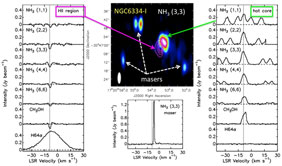
Composite of EVLA WIDAR test results toward the massive protocluster NGC6334I. Middle Top: False color image of NH3 (3,3) integrated intensity. Left: Spectra from the ultracompact HII region (magenta contours in the NH3 (3,3) image). Right: Spectra from the hot cores. Middle Bottom: Example NH3 (3,3) maser spectrum.
The formation of massive stars remains a poorly-understood phenomenon, primarily because they typically form in complex clusters, at distances of several kiloparsecs, and are often completely obscured at wavelengths <10 microns (see review by Zinnecker & Yorke 2007). With our approved RSRO project “A Diagnostic K-band Survey of Massive Young Protostellar Objects (MYSOs)'' (AB1346), we aim to observe a sample of 30 relatively unexplored MYSOs at a consistent linear resolution of < 8,000 AU, by using the EVLA D or C-configurations depending on whether their distance is 2<d<4 kpc or 4<d<6 kpc.
This survey is unique in that it will sample a wide range of massive star formation signposts -- from hot core line emission, to masers, to radio recombination lines -- simultaneously for the first time with a similar linear resolution. This project is also unique in that it requires the placement of 16 narrow bandwidth (8 MHz) sub-bands on particular lines of interest.
As part of EVLA WIDAR commissioning we recently made the first tests of such a setup, using 8 x 8 MHz sub-bands. For this test, we chose to observe the well-known massive protocluster NGC6334 (see Hunter et al. 2006), known to have strong ammonia emission from (1,1) to (6,6) (Kraemer & Jackson 1995, Beuther et al. 2005, 2007). This proto-cluster is a cluster of massive forming proto-stars that harbors two hot core sources, an ultra-compact HII region, and rare ammonia (3,3) masers. For the test, five sub-bands were placed on ammonia transitions, one on a methanol transition, one on the H64alpha radio recombination line, and the final sub-band was used for continuum.
The spectacular results, from only 10-minutes on source, are shown in Figure 1 (above). This brief test observation demonstrates the remarkable power of the new EVLA WIDAR correlator to sample a broad range of spectral lines and hence physical conditions simultaneously. We are eager to begin observing the less well-known sources in our survey using this powerful new capability.
References:
Beuther et al. 2005, ApJ, 627, 834
Beuther et al. 2007, A&A, 466, 989
Hunter et al. 2006, ApJ, 649, 888
Kraemer & Jackson, 1995, ApJ, 439, L9
No Hassle Pointing at the GBT
Frank Ghigo and Pamela Ford
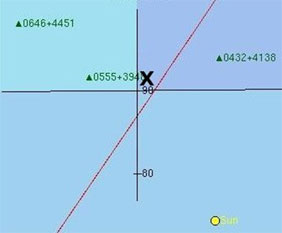
Figure 1: Near elevation = 90°, location "X" is closest to "0555+3948" in angular distance, but would require a long slew in azimuth to get there, so the source "0432+4138" will be chosen instead.
We have implemented an improved system for doing pointing and focus checks at the Green Bank Telescope (GBT). Many of our users are familiar with the AutoPeak and AutoPeakFocus procedures that can automatically choose a suitable pointing calibration source near the current telescope location or near a specified location. The choosing was sometimes beset with difficulties at high elevation or near wrap limits. Simply using the angular distance to choose the nearest calibrator might require a long slew in azimuth.
The new calibrator selection algorithm is based on Jim Condon's "calfind4" program, which addressed these problems. In the case of high elevation, the slew time was calculated, and if there was a calibrator that could be reached in a shorter time than the one closest in angular distance, that one was preferred. In the new implementation, we have not used Condon's algorithms exactly, but have calculated the time required to slew to a suitable calibrator, taking into account the elevation, wrap limits, and slew speed. The object with the shortest slew time is chosen. The new software will use the correct slew rates for its calculations, even during cold weather when the maximum azimuth rate is halved.
A source of annoyance for some users had been that the Location input had to be in J2000 coordinates. Now more coordinate systems can be used, such as B1950 and Galactic. It still does not accept ephemeris or orbital element modes for the location, but all these modes are still valid for the optional “source” input.
Along with the new algorithms, we have adopted Condon's latest pointing calibrator catalog (version 4.4) for the GBT, which includes improved flux densities from WMAP measurements at 23, 33, 41, 61, and 94 GHz, and improved positions from the latest VLBA calibrator surveys. The catalog is described in PTCS project note 66.
The selection of a calibrator uses the following criteria:
- radius: search within a specified angular distance (default is 15 degrees).
- flux : choose calibrators with flux density greater than a specified value at the observing frequency. Default is 20 times the estimated thermal noise. At the higher frequencies this estimate may be too optimistic; supplying a limit of 1.0 Jy is often helpful. The flux density at the observing frequency is estimated by interpolation in the catalog. Since many of the sources are variable, this estimate is only approximate.
- gold : if true, select only "gold standard" sources (default is false). A "gold standard" source is unresolved by the GBT, has position errors < 0.15" and is stronger than 0.4 Jy at λ=0.7cm.
An angular size criterion is also used (not under control of the user): sources are rejected if the GBT beam size is so large that the observation may be confused with nearby sources, or if the object's position accuracy is of the order of the beam size.
There is a new relax parameter that can be specified to control what is done if no calibrator is found that meets all the criteria. By default, the search radius is increased until a calibrator is found or until the radius reaches 60°. But one may tell it to relax either the flux limit or the radius limit, or both, or neither. If "neither", the user is presented with a dialog box asking what to do.
Users will, in most cases, not notice any difference with the new system. In general the user can use the defaults and be guaranteed of finding a suitable pointing calibrator requiring less than a minute of slew time.
New GBT Dynamic Scheduling System Features
Karen O'Neil

In the past few months, the GBT Dynamic Scheduling System (DSS) team has released new features of interest to all GBT observers. A brief summary of these features is follows. Full details are available on our science website and via the main DSS portal.
- User controlled Timezones: Users can now choose the default time zone of their choice for their DSS page information, as well as choosing the time zone of their choice in which to enter blackout dates.
- Schedules and Calendars: The DSS now provides iCalendar support so that investigators can see scheduled observations, blackout dates, and reservations in their favorite calendar application.
- Improved information on project pages: Project pages have been improved to make it easier for observers to gather information on their project(s). These changes include updates to the project calendar, information regarding the completion of projects and sessions, and the inclusion of project notes for the observers, schedulers, and telescope operators.
- Weather plots: Weather plots provided by Ron Maddalena that show the weather forecasts versus DSS efficiency limits are now linked at the top of all DSS web pages.
- Solar System Objects: The DSS can now automatically update the session parameter giving the target position for any solar system object.
- Projects that can Tolerate Degraded Weather: The DSS is designed to schedule projects in weather that is appropriate for the frequency being observed. Some projects can tolerate lesser weather conditions than the DSS would assign by default. To enable more aggressive scheduling, the DSS has implemented a ξ (xi) factor that is tunable to allow for observations in mildly or strongly degraded weather conditions. This factor is only turned on in agreement with the Project Friend and GBT Head of Science Operations, and will not be used to accelerate scheduling of projects that truly do benefit from the most appropriate weather.
- Blackout dates and updated documentation: The introduction to the DSS document is regularly updated with information of use to observers, and now has a clear description guiding the use (and mis-use) of blackout dates within the DSS system.
The Chandra Source Catalog
Paul Green (Harvard-CfA) and Joan Wrobel (NRAO)
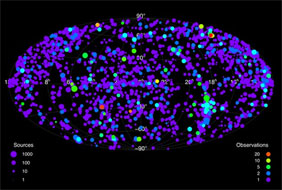
Locations of observations included in the Chandra Source Catalog, in equatorial coordinates. The symbol size is proportional to the log of the number of detected sources. The symbol color encodes the number of closely-located observations, such as those for the Hubble Deep Fields North and South. (Credit: Chandra X-ray Center)
Recognizing the strong scientific synergy between data from the Chandra X-ray Observatory and data from NRAO facilities, we wish to draw your attention to the Chandra Source Catalog (Ian N. Evans et al). Release 1.0 of the Catalog contains information on the position, multi-band fluxes and hardness ratio for more than 90,000 point and compact sources with spatial extents below ~ 30 arcseconds. The Catalog may be accessed through the CSCView data retrieval interface. A Catalog cross-match to the SDSS and a service for X-ray flux sensitivity are also available.
Observing at Pie Town VLBA Antenna Halted, Awaiting Azimuth Track Repair
Walter Brisken
On 25 May 2010, a split in the azimuth track at the Pie Town antenna was discovered. The split completely severed the steel rail and damaged the supporting layer of grout. Fortunately, the antenna structure suffered no damage. Observing at this station is on hold until the rail is repaired. In the meantime, VLBA observing will continue without Pie Town.
A preliminary repair plan calls for electric welding the rail, followed by replacement of the supporting grout. An ambitious schedule would allow science operations to be restored as early as 18 June. Since this procedure has not been used by NRAO in the past, a new 60 degree rail section will be procured to stand by as a replacement. In the event that this back-up plan needs to be invoked the projected downtime would extend through the end of July.
Please contact NRAO via the science Helpdesk if you have concerns about the impact on your observing programs.
Watch for updates on this issue and find other VLBA news on-line.
The NRAO at the 216th AAS Meeting in Miami
Mark Adams and Taylor Johnson
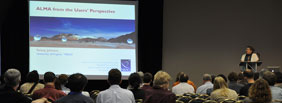
Kelsey Johnson (Univ. Virginia/NRAO) described ALMA from the Users' Perspective during the Monday evening Special Session, including proposal preparation, the proposal review process, downloading pipeline data from the archive, data analysis software, and the roles of the North American ALMA Science Center.
Miami, Florida hosted the 216th meeting of the American Astronomical Society 23 - 27 May, with 700+ scientists, teachers, students, and journalists in attendance.
The NRAO North American ALMA Science Center organized and sponsored a well attended "Preparing for ALMA" Special Session on Monday evening from 6-8 p.m. The first call for ALMA observing proposals is expected in December 2010, and the five speakers at this Special Session described the ALMA Early Science opportunity as well as the ALMA tools and support available through the North American ALMA Science Center (NAASC). The NAASC staff will provide accurate and timely information on ALMA observing modes and capabilities to the community, support users creating proposals with the ALMA Observing Tool, staff an electronic Help Desk, validate observers' scheduling blocks, and provide post-observation user support.
AAS meeting attendees also visited the NRAO exhibit to obtain information about our research facilities and project status, to view NAASC demonstrations, to converse with NRAO staff about research, and to pick up the latest brochures and other materials. Two NRAO press releases described new research results, and NRAO scientist Jay Lockman participated in a press conference on Wednesday, 26 May.
We look forward to visiting with the AAS community again at the January 2011 meeting in Seattle.
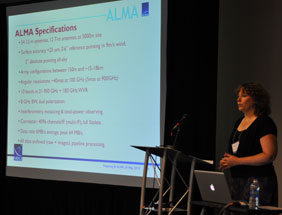
Alison Peck, Joint ALMA Observatory Deputy Project Scientist, described the current status of the ALMA construction project during the Monday evening Special Session, Preparing for ALMA.

Tom Bania (Boston Univ.) joins out-going AAS President John Huchra (Harvard Smithsonian CfA), in-coming AAS President Debra Elmegreen (Vassar), and Bruce Elmegreen (IBM-Watson) at the NRAO exhibit.
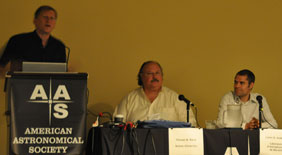
NRAO scientist Jay Lockman joined Tom Bania (Boston Univ.) and Loren Anderson (Laboratoire d'Astrophysique de Marseille) in a AAS press conference Wednesday morning, 26 May, that described recent Milky Way research results from the Green Bank Telescope.
Pulsar Search Collaboratory Selected as 2010 NSF Highlight
The National Science Foundation Directorate of Education and Human Resources has selected the NRAO – West Virginia University Pulsar Search Collaboratory project as one of its 2010 Highlights. NSF project Highlights serve to inform NSF and a diverse national constituency about a project's work and impacts. Highlights are brief descriptions of exciting NSF-funded projects that were active during the 2009-10 reporting period. Highlights are used to (1) evaluate NSF's performance, (2) inform stakeholders about NSF-funded activities, (3) capture the essence and excitement of NSF-supported research and education projects, and (4) feature emerging opportunities and challenges.
Recent Press Releases
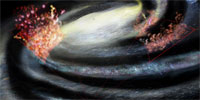 Astronomers Discover Clue to Origin of Milky Way Gas Clouds
Astronomers Discover Clue to Origin of Milky Way Gas Clouds
26 May 2010: A surprising discovery that hydrogen gas clouds found in abundance in and above our Milky Way Galaxy have preferred locations has given astronomers a key clue about the origin of such clouds, which play an important part in galaxy evolution.
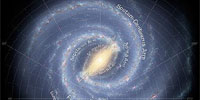 Astronomers Discover New Star-Forming Regions in Milky Way
Astronomers Discover New Star-Forming Regions in Milky Way
26 May 2010: Astronomers studying the Milky Way have discovered a large number of previously unknown regions where massive stars are being formed. Their discovery provides important new information about the structure of our home Galaxy and promises to yield new clues about the chemical composition of the Galaxy.
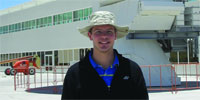 Ian Czekala Merges Engineering, Astronomy
Ian Czekala Merges Engineering, Astronomy
13 May 2010: Ian Czekala came to the University of Virginia intending to follow the "typical path" to a career in engineering. Along the way – ever looking upward – he discovered a way to merge a passion for understanding the universe with the technical knowledge to accomplish it.
Proposal Codes and Published Paper
Marsha Bishop
Have you ever received an email from the Observatory Librarian at NRAO kindly requesting your help providing Proposal Code(s) for GBT, VLA, or VLBA observations reported in a paper? The Library requests this information as the basis for linking the published paper to the data; the linking mechanism is the Proposal Code(s).
To date, the NRAO Library has added Proposal Codes to almost 2,000 bibliographic records in NRAOPapers and these records link to ADS. In addition, we provide to ADS the telescope, Proposal Code(s), and author information we add to the NRAOPapers records.
If you receive a request to provide Proposal Code(s), please know this information is utilized for your benefit to make accessing data – or the papers that use the data – quicker and easier.
For authors who would rather not receive a request for Proposal Code(s) from the Observatory Librarian, you may want to include the Proposal Code(s) in the paper; the NRAO Library is very good at finding them!
From the Archives
Ellen Bouton

About this month's photograph: The NRAO has always worked to introduce radio astronomy and to educate students, teachers, and the general public about our instruments and the exciting research conducted with them. Site tours and open houses have long been a popular and successful part of this process. In this photo, a group tours the control room of the 36-foot telescope on Kitt Peak outside Tucson, Arizona in ~ 1974. Operator Don Corderell is seated at left and Cal Sparks, with white shirt, is standing on the right. Photo by Mark Gordon, NRAO.
From the Archives is an ongoing series illustrating NRAO and U.S. radio astronomy history via images selected from our collections of individuals' and institutional papers. If readers have images they believe would be of interest to the Archives, please contact Ellen Bouton, ebouton@nrao.edu.
Career Opportunities
New Postings
Mechanical Engineer II: The National Radio Astronomy Observatory in Socorro, NM is seeking a Mechanical Engineer to carry out and assist in engineering analysis, design, and general execution of a project or whole system. The successful candidate will be responsible for recommendations, coordination and assisting in decisions on such aspects as design, procurement, manufacture, erection, test and some degree of initial operation.
Division Head (Lead Astronomer for the ALMA Proposal Handling Team): The Joint ALMA Observatory (JAO) invites applications for the position of Lead Astronomer for the Atacama Large Millimeter/submillimeter Array (ALMA) Proposal Handling Team (PHT). The Division Head will implement the ALMA Proposal Review Process, which will take place at least once per year and consists of the call for proposals, the submission process and assessments, reviews and rankings of proposals.
Co-op Student: The Electronics Division in Socorro, NM is seeking a full-time student (enrolled for the Spring 2010 semester) to work 40 hours providing support in computer programming, electronic design and/or testing. This particular work assignment will involve performing RFI and EMC testing at the Very Large Array.
Software Engineer II (CASA Programmer): The Common Astronomy Software Applications (CASA) group has an immediate need for development of high-performance computing algorithms/packages and cluster environment support. The Software Engineer will develop high-performance computing algorithms/packages and cluster environment support.
Software Engineer II: The Software Development Division in Green Bank, WV is seeking a Software Engineer to help design, develop, implement, and support the Dynamic Scheduling System for the Green Bank Telescope. The Dynamic Scheduling System is broken into three major components: a web application built with the Django web development framework, a series of custom user interfaces built with Ext GWT, and the core scheduler implemented in the functional programming language, Haskell. The Dynamic Scheduling team uses agile software development methods and automated unit testing to provide a working system for sponsors at every step of system development.

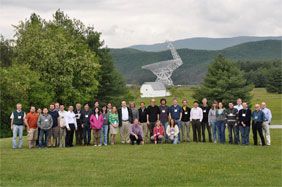
 Zoom
Zoom